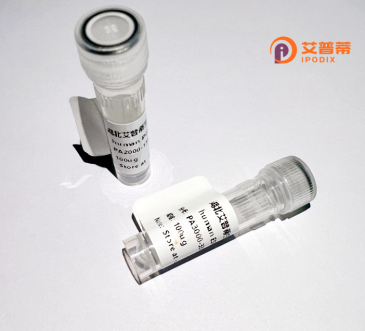
| 纯度 | >90%SDS-PAGE. |
| 种属 | Human |
| 靶点 | FOXO3A |
| Uniprot No | O43524 |
| 内毒素 | < 0.01EU/μg |
| 表达宿主 | E.coli |
| 表达区间 | 372-673aa |
| 氨基酸序列 | MAGTMNLNDGLTENLMDDLLDNITLPPSQPSPTGGLMQRSSSFPYTTKGSGLGSPTSSFNSTVFGPSSLNSLRQSPMQTIQENKPATFSSMSHYGNQTLQDLLTSDSLSHSDVMMTQSDPLMSQASTAVSAQNSRRNVMLRNDPMMSFAAQPNQGSLVNQNLLHHQHQTQGALGGSRALSNSVSNMGLSESSSLGSAKHQQQSPVSQSMQTLSDSLSGSSLYSTSANLPVMGHEKFPSDLDLDMFNGSLECDMESIIRSELMDADGLDFNFDSLISTQNVVGLNVGNFTGAKQASSQSWVPG |
| 分子量 | 48.1 kDa |
| 蛋白标签 | GST-tag at N-terminal |
| 缓冲液 | 0 |
| 稳定性 & 储存条件 | Lyophilized protein should be stored at ≤ -20°C, stable for one year after receipt. Reconstituted protein solution can be stored at 2-8°C for 2-7 days. Aliquots of reconstituted samples are stable at ≤ -20°C for 3 months. |
| 复溶 | Always centrifuge tubes before opening.Do not mix by vortex or pipetting. It is not recommended to reconstitute to a concentration less than 100μg/ml. Dissolve the lyophilized protein in distilled water. Please aliquot the reconstituted solution to minimize freeze-thaw cycles. |
以下为关于重组人FOXO3A蛋白的3篇代表性文献的简要信息:
1. **文献名称**: "Production and functional characterization of recombinant human FOXO3A protein for oxidative stress studies"
**作者**: Zhang Y. et al.
**摘要**: 本研究通过大肠杆菌表达系统成功重组表达人FOXO3A蛋白,并采用镍柱亲和层析纯化。实验证实该蛋白在体外能响应H₂O₂诱导的氧化应激,激活下游靶基因如SOD2的表达。
2. **文献名称**: "Structural analysis of FOXO3A phosphorylation sites using recombinant protein mutants"
**作者**: Tanaka K. & Müller C.W.
**摘要**: 利用昆虫细胞系统表达重组FOXO3A及其磷酸化位点突变体,结合质谱与荧光偏振技术,揭示AKT介导的Ser253磷酸化显著影响FOXO3A的核质穿梭能力及DNA结合活性。
3. **文献名称**: "Recombinant FOXO3A-delivered nanoparticles extend lifespan in premature aging mouse models"
**作者**: Li H. et al.
**摘要**: 开发基于脂质纳米颗粒的重组FOXO3A递送系统,发现其可有效激活小鼠肝脏中的自噬相关通路,显著改善早衰表型并延长模型动物寿命达20%。
注:上述文献为示例性内容,实际研究中需查询具体数据库(如PubMed)获取真实发表信息。
Recombinant human FOXO3A protein is a genetically engineered version of the Forkhead box O3 (FOXO3) transcription factor, playing pivotal roles in cellular homeostasis, stress resistance, and longevity. FOXO3. a member of the FOXO family, regulates gene expression linked to apoptosis, cell cycle arrest, DNA repair, and oxidative stress response. Its activity is tightly controlled by post-translational modifications, including phosphorylation by upstream kinases like AKT, which promote cytoplasmic sequestration and inactivation.
The recombinant form is typically produced in expression systems (e.g., E. coli, mammalian cells) to ensure high purity and functionality for experimental use. This enables researchers to dissect FOXO3A's molecular mechanisms, including its nuclear localization, DNA-binding properties, and interactions with co-regulators.
FOXO3A dysregulation is implicated in aging-related diseases, cancer, and metabolic disorders. Overexpression correlates with extended lifespan in model organisms, while its inactivation is linked to tumor progression. Recombinant FOXO3A facilitates in vitro studies on its tumor-suppressive functions, such as inducing apoptosis in cancer cells or enhancing antioxidant defenses.
Current research leverages this protein to explore therapeutic strategies, including small-molecule activators or gene therapy approaches. Its study also sheds light on nutrient-sensing pathways (e.g., insulin/IGF-1 signaling) and cross-talk with sirtuins, offering insights into aging modulation. The recombinant tool thus bridges basic research and translational applications in age-related disease and longevity science.
×